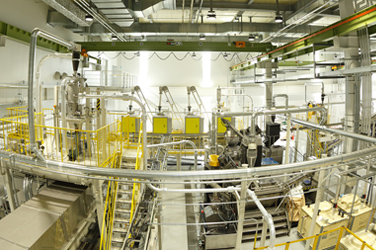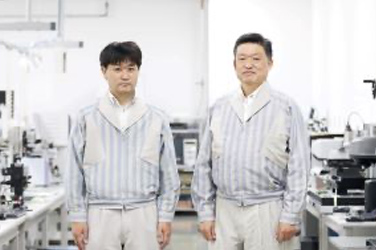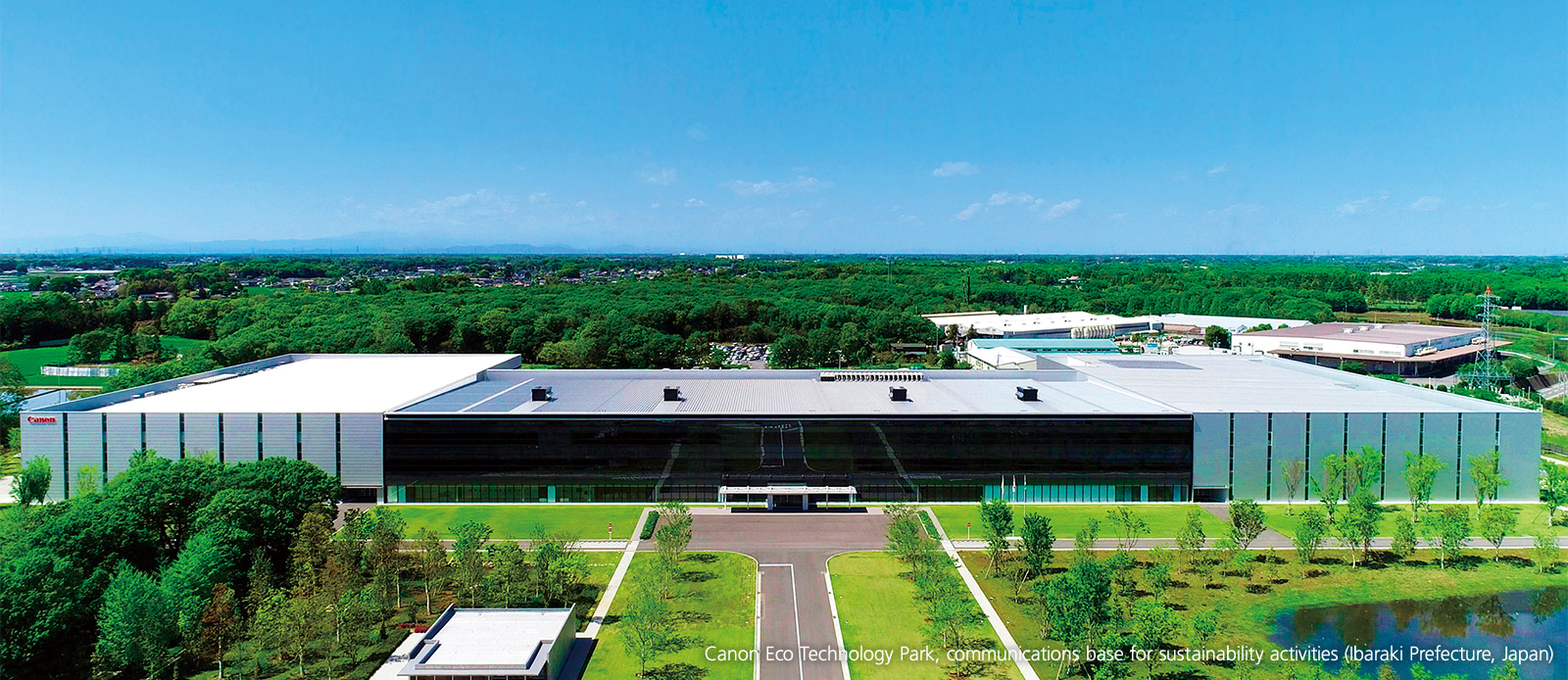

A Technology Infrastructure That Helps Reduce the Environmental Impact of All Our Products and Corporate Activities
Green Platform
Canon has been ahead of its time in creating environmentally conscious products. We have been involved in efforts across the entire product lifecycle, not only to conserve resources and power, but also to reuse and recycle products. In response to changes in society surrounding environmental issues, we have organized these technologies and knowledge into a company-wide technology infrastructure called the Green Platform to strengthen our activities.
October 16, 2023
Organized as a Technology Infrastructure Based on the Environmentally Conscious Systems and Technologies That Canon Has Accumulated over the Years.
In recent years, amidst the demand to realize a sustainable society, growing attention is being paid to the sustainability of corporate activity, including the Green Transformation (GX). Since its founding, Canon has remained ahead of its time in working to conserve resources and power while continuing, through technology, to offer products and services that benefit our customers. In 1993, we established the Canon Group Environmental Charter. Under this charter based on the concept of EQCD (Environment, Quality, Cost, Delivery), we position the Environment as a matter of priority over Quality, Cost, and Delivery. We have conducted business under the EQCD concept and belief that, “Companies are not qualified to manufacture goods if they are incapable of environmental assurance.”
The Green Platform is a technology infrastructure that comprehensively helps Canon’s business activities, based on the environmentally conscious systems and technologies that Canon has accumulated over the years. Canon contributes to minimizing environmental impact, including decarbonization and improvement of resource efficiency, by combining and utilizing a variety of proprietary technologies at each stage. This includes design (power-saving, resource-saving, recycling-oriented design, etc.), production (reduction of power, water, and waste, etc.), and reuse (repair, reuse, recycling, etc.).

Canon‘s Green Platform
Promoting Reuse Initiatives Ahead of the Circular Economy
Looking across its entire product lifecycle, Canon has established five recycling sites in Japan, North America, Europe (two sites), and China. We have put in place a structure for improvement of resource efficiency in the regions where they are consumed, and created a system for recycling and reuse. We began collecting used toner cartridges recycle programs in 1990, in response to the explosive growth of laser printers. If you were to lay end-to-end all of the toner cartridges we’ve recycled to date, they would circle the Earth four times. At Canon Eco Technology Park, opened in 2018, state-of-the-art automated recycling lines have been implemented to further boost recycling efficiency. Used toner cartridges are crushed and the materials automatically separated for recycling of the main component, high-impact polystyrene (HIPS). The sorting purity of the recycled plastic reaches 99% or greater with the intensive use of various separation technologies.
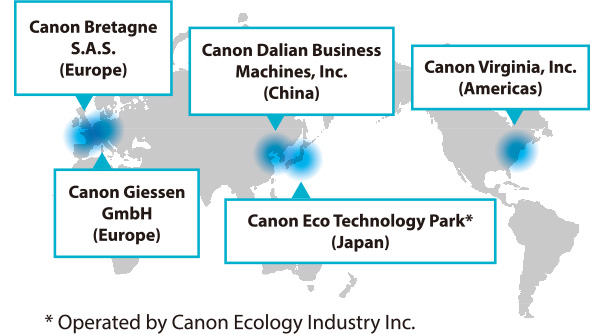
Canon’s global recycling sites
Since 1992, Canon has also undertaken “remanufacturing” of used multifunction devices, refurbishing them to be good-as-new quality. We collect unneeded multifunction devices from offices, remove the exterior covers and each unit, break them down into parts, which are cleaned and inspected them. All parts that meet our standards for use are reused, while the parts that show wear or deterioration are replaced with new parts. These machines are then reassembled and checked to ensure they deliver the same quality as a new product before being sold. In addition, we have been taking regeneration into consideration from the product development stage. We design products that are easy to sort and can withstand repeated use. We have achieved a reused parts ratio of over 90% in our latest models, and have actively engaged in efforts to contribute to resource efficiency and minimize our environmental impact.
Furthermore, Canon has designed a new stain-resistant toner bottle that minimizes toner adhesion and messy leaks for consumables. We are also working on toner refill, taking into account ease of collection for customers and ease of recycling at Canon after product use. We are also working on toner bottle refill production, taking into account ease of collection for customers and ease of recycling at Canon after product use. In addition, from inkjet printers for home use to cameras that meet professional needs, we are equipped to handle repairs.

Remanufacturing of a multifunction device
Advancing Decarbonization throughout the Product Lifecycle
Canon is working to save power and resources to reduce CO2 emissions throughout the entire product lifecycle, including material procurement, production, transport, use, and reuse. Using our proprietary simulation technology, Canon develops to conserve resources and power in the product life cycle in product design.
We reduce environmental impact by reducing resources used in products and improving transport efficiency during delivery.
In addition, we help reduce environmental impact throughout the product lifecycle by the reduction in size and weight of products.
For example, in the development of laser printers, it was difficult to downsize the product beyond a certain level due to the need for components to cool the heat during toner fixing and the path (space) for printing paper. Canon accurately simulates the flow of heat, wind, and paper during product design. Thermal updrafts create air flow inside the product, eliminating the need for cooling fans. In addition, the structure (shape) and arrangement of the members were optimized by minimizing the curve of the paper path. As a result of these efforts, we are realizing products that are miniaturized (resource-saving).
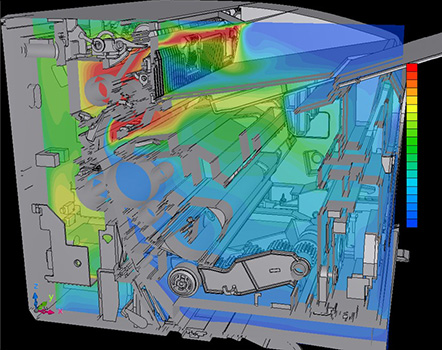
Simulation of Heat Flow Contributing to the Miniaturization of Laser Printers
In order to further reduce the amount of power consumed during production, Canon are developing a system that enables detailed visualization and analysis of the state of power consumption for each process in the factory.
By disaggregating factory power not only by location but also by operation of production facilities, we can thoroughly identify hidden "power waste."
We will accelerate the decarbonization of our production sites by deploying this system throughout the company to efficiently reduce power consumption.
Further Advance Our Green Platform to Improve Product Competitiveness in all Businesses
For example, Canon is using new technologies to address the challenge of miniaturizing circuit patterns, which are essential for the evolution of the semiconductor chips that now support the development of all industries. Until now, the process of optically exposing circuits have been the key to miniaturization in semiconductor manufacturing technology. However, further advancing miniaturization in circuit formation using photolithography requires the wavelength of the light to be shortened, and the latest lithography equipment using far ultraviolet light present such problems of large equipment size and enormous power consumption.
The nanoimprint lithography technology developed by Canon is an alternative to semiconductor circuit formation using conventional lithography. In this completely new semiconductor manufacturing process, circuit patterns are formed by stamping and are then fixed by UV curing. This makes possible more compact equipment and overwhelming power-savings. The technology has already been perfected to a level where memory circuits can be formed, and it is expected to be developed further, enabling semiconductor manufacturing that can handle even more complex logic circuits.
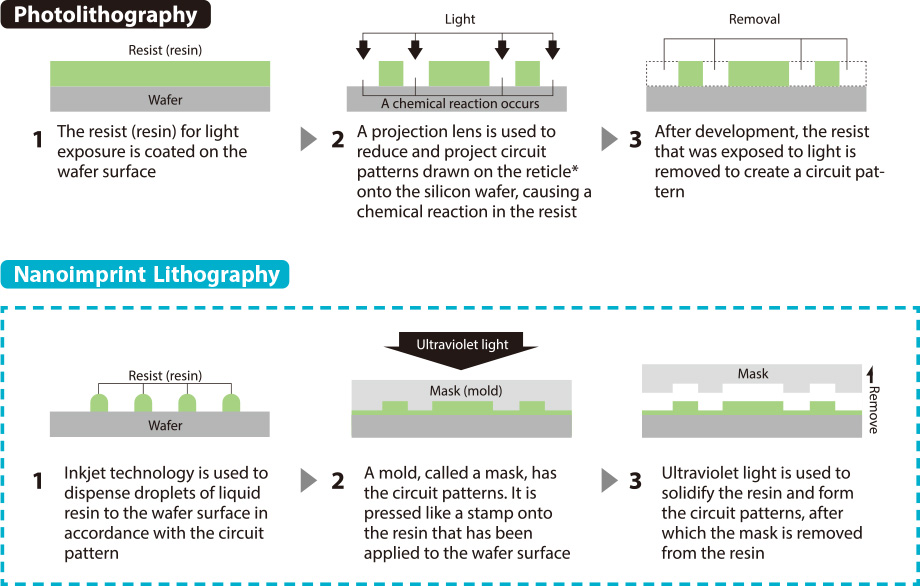
*Photomask used in semiconductor manufacturing
Green Platform has been cultivated through product development under the culture of combining different technical fields within Canon.
This Green Platform is the technology infrastructure for adapting to the coming age in which there is a dramatically increasing social demand for reducing environmental impact, and it is the source of Canon’s competitiveness in creating strong products.
Canon advances its Green Platform and contribute to the decarbonization and improvement of resource efficiency.


